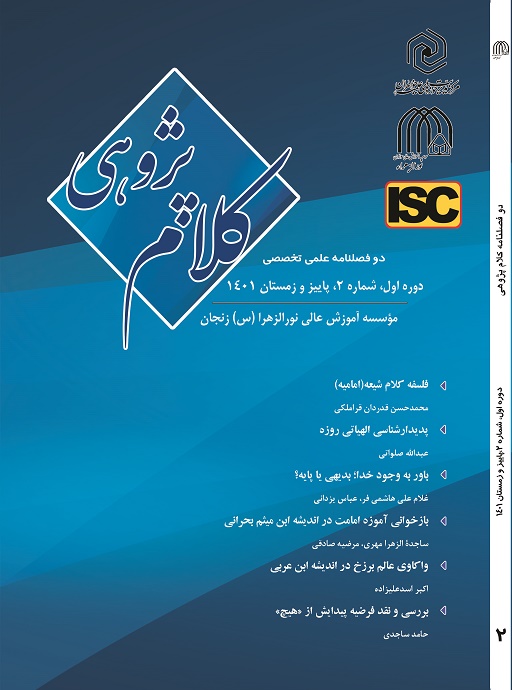وصول به رستگاری با تکیه بر بهگود-گیتا و قرآن کریم
نوع مقاله : مقاله پژوهشی
نویسنده
دانشجوی دکتری الهیات و معارف اسلامی(ادیان و عرفان)
چکیده
رستگاری انسان که جزء دغدغههای مهم الاهیاتی در ادیان مختلف و متون مقدس آنها است از مسائل و تأملات آیین هندویی و اسلام نیز میباشد که مفاهیم، روشها و شیوههای وصول به آن در بهگود-گیتا و قرآن کریم مشهود است. بهگود-گیتا که شهد اصلی مهابهارته و انجیل هندوها خوانده میشود، رستگاری(مُکشه) را آرمانی متعالی معرفی نموده و به آن از دو جنبه سلبی و ایجابی نظر دارد. در گیتا به صورت واضح سه طریقه (مارگه / یوگه)، کرمه یوگه (راه کردار یا عمل)، جنانه یوگه (راه معرفت) و بهکتی یوگه (راه عشق و دلدادگی) برای نیل به رستگاری نهایی (مُکشه) ترسیم شده است. قرآنکریم که برای همه جنبههای زندگی بشر برنامه مدّون دارد، هدف و غایت تعلیمات آن، نجات و رستگاری انسان است، چرا که موضوع قرآن، انسان است. حقیقت رستگاری در قرآن یک معنای عدمی و سلبی است که به معنای رهایی و یا دوری از مصیبت، درد و رنج، خلاصی از گناه میباشد که معنای اصلی آن با مفاهیم سعادت، فوز، فلاح و...که در بردارنده معنای وصول که مفهومی ایجابی است تا حدودی متفاوت است. ایمان و عمل صالح درقرآنکریم، بهعنوان دو راه مهم و اصلی برای نیل به رستگاری ترسیم شده اما شاخصهها، ملاکها و مصادیق گوناگونی برای آنها درنظر گرفته شده است. این نوشتار ضمن مطالعه مفهوم مکشه در گیتا و نجات و رستگاری در قرآنکریم، به بررسی شیوههای وصول به رستگاری نهایی با محوریت گیتا و قرآنکریم میپردازد.
عنوان مقاله [English]
Reaching Salvation by Confidence on Bhagavad Gita (भगवद्गीता) and the Holy Quran
نویسنده [English]
- noormohammad ansari
PhD student of theology and Islamic studies (religions and mysticism
چکیده [English]
The salvation of man, which is part of the important theological concerns in various religions and their holy texts, is also one of the issues and reflections of Hinduism and Islam, as the concepts, methods, and practices of reaching it are evident in the Bhagavad Gita and the Holy Quran. Bhagavad Gita, which is called the main nectar of Mahabharata and the Bible of Hindus, introduces salvation (moksha) as a supreme ideal and views it from both negative and positive characteristics. In the Gita, three methods (marga/yoga), karma yoga (the path of action or action), jnana yoga (the path of knowledge) and bhakti yoga (the path of love and affection) are drawn to accomplish the final salvation (moksha). The Holy Qur'an, which has written plans for all aspects of human life, the purpose and goal of its teachings, is the salvation of man because the subject of the Qur'an is man. The truth of salvation in the Qur'an is a non-existent meaning, which signifies deliverance or avoidance of calamity, pain and suffering, and freedom from sin, whose main meaning is interrelated to the concepts of happiness, fortune, welfare, etc.. In the Holy Quran, faith and righteous actions are drawn as two main ways to reach salvation, but various indicators, criteria and examples are considered for them. This article, while studying the concept of Moksha in the Gita and salvation and redemption in the Holy Quran, examines the methods of reaching the final salvation with a focus on the Gita and the Holy Quran.
کلیدواژهها [English]
- Bhagavad Gita
- Holy Quran
- salvation
- Moksha
- faith
- righteous action
دوره 1، شماره 2 - شماره پیاپی 2
بهمن 1401
- تاریخ دریافت: 10 بهمن 1402
- تاریخ پذیرش: 10 بهمن 1402
- تاریخ اولین انتشار: 10 بهمن 1402
 کلام پژوهی
کلام پژوهی
